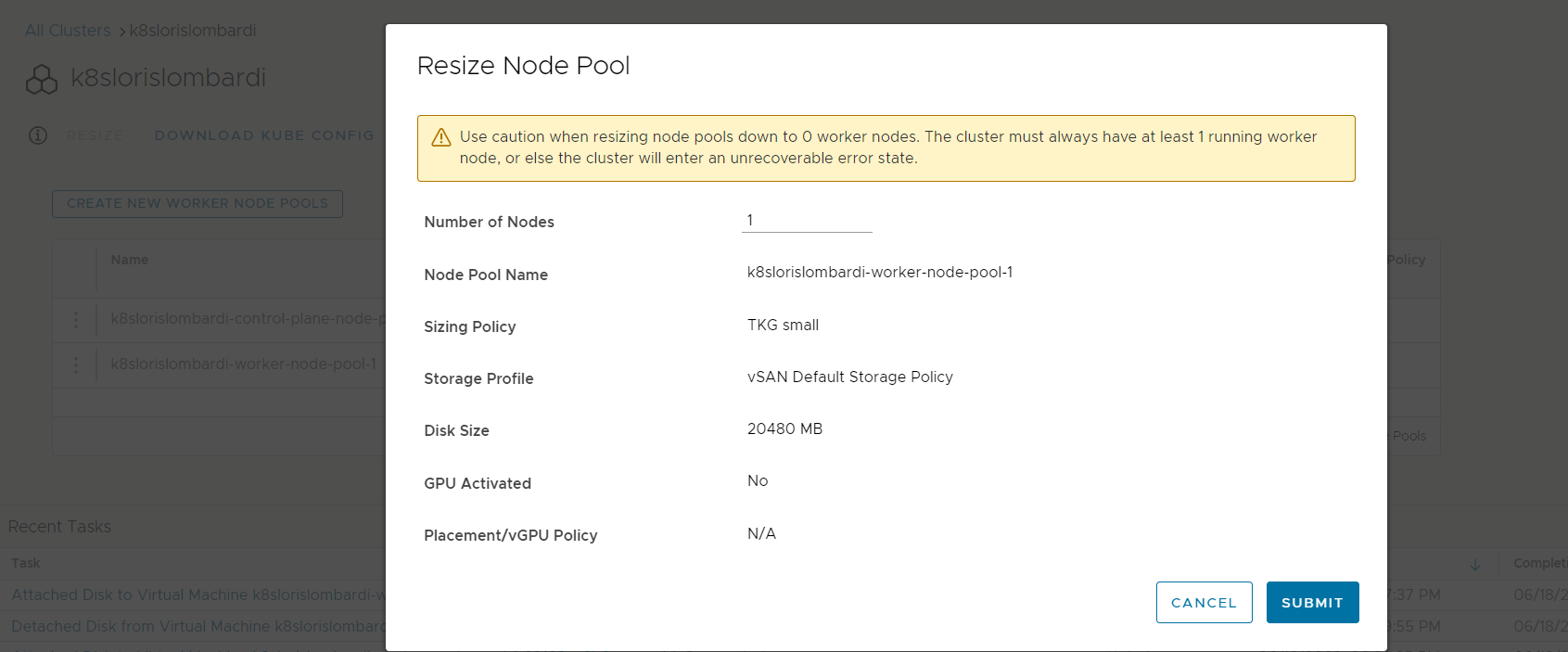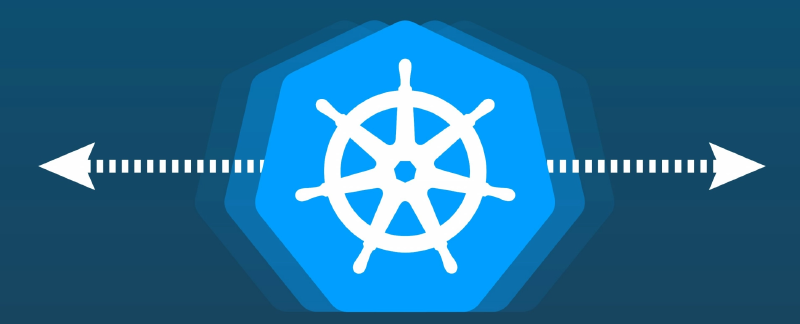In this article we’ll configure worker node autoscaling for a Kubernetes cluster deployed with Contaier Service Extension 4.0.3. This feature is very useful when using HPA (Horizontal Pod Autoscaling). It allows you to deploy additional Worker nodes according to the load required by your applications.
Requirements
- A working Kubernetes cluster deployed with Container Service Extension
- Some knowledge of Kubernetes
Test environment
1
2
3
4
|
k get node
NAME STATUS ROLES AGE VERSION
k8slorislombardi-control-plane-node-pool-njdvh Ready control-plane,master 21h v1.21.11+vmware.1
k8slorislombardi-worker-node-pool-1-69f68cc6b9-kfhz9 Ready <none> 21h v1.21.11+vmware.1
|
- 1 Master node : 2vCPU ; 4Go RAM
- 1 Worker node : 2vCPU ; 4Go RAM
Configuration HPA
Metrics configuration
If you haven’t already done so, you need to deploy metrics-server on your Kubernetes cluster.
1
|
kubectl apply -f https://github.com/kubernetes-sigs/metrics-server/releases/latest/download/components.yaml
|
We need to edit the metric server deployment as follows
1
|
k edit deployments.apps metrics-server -n kube-system
|
Enable option –kubelet-insecure-tls
1
2
3
4
5
6
7
8
9
10
|
containers:
- args:
- --cert-dir=/tmp
- --secure-port=4443
- --kubelet-preferred-address-types=ExternalIP,Hostname,InternalIP
- --kubelet-use-node-status-port
- --metric-resolution=15s
- --kubelet-insecure-tls
image: registry.k8s.io/metrics-server/metrics-server:latest
imagePullPolicy: IfNotPresent
|
HPA test
From the following template, we will configure a deployment and associate it with an HPA policy.
1
2
3
4
5
6
7
8
9
10
11
12
13
14
15
16
17
18
19
20
21
22
23
24
25
26
27
28
29
30
31
32
33
34
35
36
37
|
# hpa-test.yaml
apiVersion: apps/v1
kind: Deployment
metadata:
name: hpa-example
spec:
replicas: 1
selector:
matchLabels:
app: hpa-example
template:
metadata:
labels:
app: hpa-example
spec:
containers:
- name: hpa-example
image: gcr.io/google_containers/hpa-example
ports:
- name: http-port
containerPort: 80
resources:
requests:
cpu: 200m
---
apiVersion: autoscaling/v1
kind: HorizontalPodAutoscaler
metadata:
name: hpa-example-autoscaler
spec:
scaleTargetRef:
apiVersion: apps/v1
kind: Deployment
name: hpa-example
minReplicas: 1
maxReplicas: 100
targetCPUUtilizationPercentage: 50
|
1
|
k apply -f hpa-test.yaml
|
Check
1
2
3
4
5
6
7
8
9
10
11
12
13
|
k get deployments.apps
NAME READY UP-TO-DATE AVAILABLE AGE
hpa-example 1/1 1 1 3m21s
k get hpa
NAME REFERENCE TARGETS MINPODS MAXPODS REPLICAS AGE
hpa-example-autoscaler Deployment/hpa-example 0%/50% 1 10 1 28m
k get pod
NAME READY STATUS RESTARTS AGE
hpa-example-cb54bb958-cggfp 1/1 Running 0 3m26s
nginx-nfs-example 1/1 Running 0 12h
|
We then create a Load-balancer VIP for our deployment
1
|
k expose deployment hpa-example --type=LoadBalancer --port=80
|
In our example, the load-balancer assigns the IP 172.31.7.210
1
2
3
4
|
k get svc
NAME TYPE CLUSTER-IP EXTERNAL-IP PORT(S) AGE
hpa-example LoadBalancer 100.68.137.181 172.31.7.210 80:32258/TCP 14s
kubernetes ClusterIP 100.64.0.1 <none> 443/TCP 20h
|
Load up
We are now going to ramp up our application
1
2
3
4
5
6
7
8
9
10
|
# pod-wget.yaml
apiVersion: v1
kind: Pod
metadata:
name: pod-wget
spec:
containers:
- name: alpine
image: alpine:latest
command: ['sleep', 'infinity']
|
1
2
3
4
|
k apply -f po-wget.yaml
k exec -it pod-wget -- sh
/ # while true; do wget -q -O- http://172.31.7.210;done
OK!OK!OK!OK!OK!OK!OK!OK!OK!OK!OK!OK!OK!OK!OK!OK!OK!OK!OK!OK!OK!OK!OK!OK!OK!OK!OK!OK!OK!OK!OK!OK!OK!OK!OK!OK!
|
After a few minutes, you can see the HPA feature in action
Hight CPU utilization for pod
1
2
3
|
k get hpa
NAME REFERENCE TARGETS MINPODS MAXPODS REPLICAS AGE
hpa-example-autoscaler Deployment/hpa-example 381%/50% 1 10 4 35m
|
You can see that the HPA is trying to create a new POD, but the CPU resources of the worker node are also too hight
1
2
3
4
5
6
7
8
9
10
11
12
13
14
15
|
k get pod
NAME READY STATUS RESTARTS AGE
hpa-example-cb54bb958-2sqpt 0/1 Pending 0 67s
hpa-example-cb54bb958-44k4x 0/1 Pending 0 52s
hpa-example-cb54bb958-6vd5l 0/1 Pending 0 52s
hpa-example-cb54bb958-82fb4 0/1 Pending 0 82s
hpa-example-cb54bb958-dpwwc 1/1 Running 0 40m
hpa-example-cb54bb958-ltb96 0/1 Pending 0 67s
hpa-example-cb54bb958-nsd54 0/1 Pending 0 67s
hpa-example-cb54bb958-w74fx 0/1 Pending 0 82s
hpa-example-cb54bb958-wz54z 1/1 Running 0 82s
hpa-example-cb54bb958-zrgw4 0/1 Pending 0 67s
k describe pod hpa-example-cb54bb958-2sqp
Warning FailedScheduling 11s (x3 over 82s) default-scheduler 0/2 nodes are available: 1 Insufficient cpu, 1 node(s) had taint {node-role.kubernetes.io/master: }, that the pod didn't tolerate.
|
Enable autoscaling
This feature is not enabled by default on Kubernetes clusters deployed by CSE and is not yet implemented by VMware. Here’s a step-by-step method for configuring this feature while we wait for it to be integrated into the development roadmap.
Preparing the necessary components
Identify your cluster’s admin namespace. In this example, my cluster is named k8slorislombardi
1
2
3
4
5
6
7
8
9
10
11
12
13
14
15
16
17
18
19
|
k get namespaces
NAME STATUS AGE
capi-kubeadm-bootstrap-system Active 21h
capi-kubeadm-control-plane-system Active 21h
capi-system Active 21h
capvcd-system Active 21h
cert-manager Active 21h
default Active 21h
hpa-test Active 93m
k8slorislombardi-ns Active 21h
kube-node-lease Active 21h
kube-public Active 21h
kube-system Active 21h
nfs-csi Active 15h
rdeprojector-system Active 21h
tanzu-package-repo-global Active 21h
tkg-system Active 21h
tkg-system-public Active 21h
tkr-system Active 21h
|
The “admin” namespace for this cluster is therefore k8slorislombardi-ns.
All the steps below must be performed in the “admin” namespace: k8slorislombardi-ns
- Create a temporary pod and a PVC containing our kubeconfig
1
2
3
4
5
6
7
8
9
10
11
12
13
14
15
16
17
18
19
20
21
22
23
24
25
26
27
28
29
30
31
32
|
#autoscale-config.yaml
apiVersion: v1
kind: PersistentVolumeClaim
metadata:
annotations:
volume.beta.kubernetes.io/storage-provisioner: named-disk.csi.cloud-director.vmware.com
name: pvc-autoscaler
spec:
accessModes:
- ReadWriteOnce
resources:
requests:
storage: 10Mi
storageClassName: default-storage-class-1
volumeMode: Filesystem
---
apiVersion: v1
kind: Pod
metadata:
name: pod-temporaire
spec:
containers:
- name: alpine
image: alpine:latest
command: ['sleep', 'infinity']
volumeMounts:
- name: pvc-autoscaler
mountPath: /data
volumes:
- name: pvc-autoscaler
persistentVolumeClaim:
claimName: pvc-autoscaler
|
Implementation and checking
1
2
3
4
5
6
7
8
9
|
k apply -f autoscale-config.yaml
k get pvc
NAME STATUS VOLUME CAPACITY ACCESS MODES STORAGECLASS AGE
pvc-autoscaler Bound pvc-775762d2-34e7-4854-823d-8f757d94437e 10Mi RWO default-storage-class-1 3m8s
k get pod
NAME READY STATUS RESTARTS AGE
pod-temporaire 1/1 Running 0 2m57s
|
- Copy kubeconfig file
1
2
3
4
5
|
k exec -it pod-temporaire -- sh
/ #
/ # cd /data
/data #
vi config
|
Copy the contents of your kubeconfig into a new file named config
You can then delete the pod-temporary
1
|
k delete pod pod-temporaire
|
- Configure worker-node pool hardware resources
1
2
3
4
5
|
k get machinedeployments.cluster.x-k8s.io
NAME CLUSTER REPLICAS READY UPDATED UNAVAILABLE PHASE AGE VERSION
k8slorislombardi-worker-node-pool-1 k8slorislombardi 1 1 1 0 Running 23h v1.21.11+vmware.1
k edit machinedeployments.cluster.x-k8s.io k8slorislombardi-worker-node-pool-1
|
We modify the parameters of the machinedeployments.cluster.x-k8s.io property to define :
- The maximum and minimum number of worker-nodes in the pool
- Worker-node hardware resources to be deployed
1
2
3
4
5
6
7
8
9
10
11
12
13
|
apiVersion: cluster.x-k8s.io/v1beta1
kind: MachineDeployment
metadata:
annotations:
kubectl.kubernetes.io/last-applied-configuration: |
{"apiVersion":"cluster.x-k8s.io/v1beta1","kind":"MachineDeployment","metadata":{"annotations":{},"creationTimestamp":null,"name":"k8slorislombardi-worker-node-pool-1","namespace":"k8slorislombardi-ns"},"spec":{"clusterName":"k8slorislombardi","replicas":1,"selector":{},"template":{"metadata":{},"spec":{"bootstrap":{"configRef":{"apiVersion":"bootstrap.cluster.x-k8s.io/v1beta1","kind":"KubeadmConfigTemplate","name":"k8slorislombardi-worker-node-pool-1","namespace":"k8slorislombardi-ns"}},"clusterName":"k8slorislombardi","infrastructureRef":{"apiVersion":"infrastructure.cluster.x-k8s.io/v1beta1","kind":"VCDMachineTemplate","name":"k8slorislombardi-worker-node-pool-1","namespace":"k8slorislombardi-ns"},"version":"v1.21.11+vmware.1"}}},"status":{"availableReplicas":0,"readyReplicas":0,"replicas":0,"unavailableReplicas":0,"updatedReplicas":0}}
cluster.x-k8s.io/cluster-api-autoscaler-node-group-max-size: "5"
cluster.x-k8s.io/cluster-api-autoscaler-node-group-min-size: "1"
capacity.cluster-autoscaler.kubernetes.io/memory: "4"
capacity.cluster-autoscaler.kubernetes.io/cpu: "2"
capacity.cluster-autoscaler.kubernetes.io/ephemeral-disk: "20Gi"
capacity.cluster-autoscaler.kubernetes.io/maxPods: "200"
machinedeployment.clusters.x-k8s.io/revision: "1"
|
Deploying the autoscaler
We use the following yaml to use the previously created PVC to retrieve the kubeconfig.
Be sure to replace k8slorislombardi and k8slorislombardi-ns with your cluster parameters
1
2
3
4
5
6
7
8
9
10
11
12
13
14
15
16
17
18
19
20
21
22
23
24
25
26
27
28
29
30
31
32
33
34
35
36
37
38
39
40
41
42
43
44
45
46
47
48
49
50
51
52
53
54
55
56
57
58
59
60
61
62
63
64
65
66
67
68
69
70
71
72
73
74
75
76
77
78
79
80
81
82
83
84
85
86
87
88
89
90
91
92
93
94
95
96
97
98
99
100
101
102
103
104
105
106
107
108
109
110
111
112
113
114
115
116
117
118
119
120
121
122
123
124
125
126
127
128
129
130
131
132
133
134
135
136
137
138
139
140
141
142
143
144
145
146
147
148
149
150
151
152
153
154
155
156
157
158
159
160
161
162
163
164
165
166
167
168
169
170
171
172
173
174
175
176
177
178
179
180
|
apiVersion: apps/v1
kind: Deployment
metadata:
name: cluster-autoscaler
namespace: k8slorislombardi-ns
labels:
app: cluster-autoscaler
spec:
selector:
matchLabels:
app: cluster-autoscaler
replicas: 1
template:
metadata:
labels:
app: cluster-autoscaler
spec:
containers:
- image: us.gcr.io/k8s-artifacts-prod/autoscaling/cluster-autoscaler:v1.20.0
name: cluster-autoscaler
command:
- /cluster-autoscaler
args:
- --cloud-provider=clusterapi
- --kubeconfig=/data/config
- --cloud-config=/data/config
- --node-group-auto-discovery=clusterapi:clusterName=k8slorislombardi
- --namespace=k8slorislombardi-ns
- --node-group-auto-discovery=clusterapi:namespace=default
volumeMounts:
- name: pvc-autoscaler
mountPath: /data
volumes:
- name: pvc-autoscaler
persistentVolumeClaim:
claimName: pvc-autoscaler
serviceAccountName: cluster-autoscaler
terminationGracePeriodSeconds: 10
---
kind: ClusterRoleBinding
apiVersion: rbac.authorization.k8s.io/v1
metadata:
name: cluster-autoscaler-workload
roleRef:
apiGroup: rbac.authorization.k8s.io
kind: ClusterRole
name: cluster-autoscaler-workload
subjects:
- kind: ServiceAccount
name: cluster-autoscaler
namespace: k8slorislombardi-ns
---
kind: ClusterRoleBinding
apiVersion: rbac.authorization.k8s.io/v1
metadata:
name: cluster-autoscaler-management
roleRef:
apiGroup: rbac.authorization.k8s.io
kind: ClusterRole
name: cluster-autoscaler-management
subjects:
- kind: ServiceAccount
name: cluster-autoscaler
namespace: k8slorislombardi-ns
---
apiVersion: v1
kind: ServiceAccount
metadata:
name: cluster-autoscaler
namespace: k8slorislombardi-ns
---
kind: ClusterRole
apiVersion: rbac.authorization.k8s.io/v1
metadata:
name: cluster-autoscaler-workload
rules:
- apiGroups:
- ""
resources:
- namespaces
- persistentvolumeclaims
- persistentvolumes
- pods
- replicationcontrollers
- services
verbs:
- get
- list
- watch
- apiGroups:
- ""
resources:
- nodes
verbs:
- get
- list
- update
- watch
- apiGroups:
- ""
resources:
- pods/eviction
verbs:
- create
- apiGroups:
- policy
resources:
- poddisruptionbudgets
verbs:
- list
- watch
- apiGroups:
- storage.k8s.io
resources:
- csinodes
- storageclasses
- csidrivers
- csistoragecapacities
verbs:
- get
- list
- watch
- apiGroups:
- batch
resources:
- jobs
verbs:
- list
- watch
- apiGroups:
- apps
resources:
- daemonsets
- replicasets
- statefulsets
verbs:
- list
- watch
- apiGroups:
- ""
resources:
- events
verbs:
- create
- patch
- apiGroups:
- ""
resources:
- configmaps
verbs:
- create
- delete
- get
- update
- apiGroups:
- coordination.k8s.io
resources:
- leases
verbs:
- create
- get
- update
---
kind: ClusterRole
apiVersion: rbac.authorization.k8s.io/v1
metadata:
name: cluster-autoscaler-management
rules:
- apiGroups:
- cluster.x-k8s.io
resources:
- machinedeployments
- machinedeployments/scale
- machines
- machinesets
verbs:
- get
- list
- update
- watch
|
Check
1
2
3
4
5
6
7
8
9
10
11
|
k apply -f .\autoscale.yaml
deployment.apps/cluster-autoscaler created
clusterrolebinding.rbac.authorization.k8s.io/cluster-autoscaler-workload created
clusterrolebinding.rbac.authorization.k8s.io/cluster-autoscaler-management created
serviceaccount/cluster-autoscaler created
clusterrole.rbac.authorization.k8s.io/cluster-autoscaler-workload created
clusterrole.rbac.authorization.k8s.io/cluster-autoscaler-management created
k get pod
NAME READY STATUS RESTARTS AGE
cluster-autoscaler-79c5cb9df6-gqlfd 1/1 Running 0 29s
|
rdeprojector configuration
By default, Cloud director continuously checks the configuration of your Kubernetes cluster via the rdeprojector controller. This controller can also be used to add or remove workers from the cloud director GUI.

1
|
k edit deployments.apps rdeprojector-controller-manager -n rdeprojector-system
|
Scale down th replica at 0
1
2
3
4
5
6
7
|
spec:
progressDeadlineSeconds: 600
replicas: 0
revisionHistoryLimit: 10
selector:
matchLabels:
control-plane: controller-manager
|
Test Autoscaling
1
2
3
4
|
k apply -f po-wget.yaml
k exec -it pod-wget -- sh
/ # while true; do wget -q -O- http://172.31.7.210;done
OK!OK!OK!OK!OK!OK!OK!OK!OK!OK!OK!OK!OK!OK!OK!OK!OK!OK!OK!OK!OK!OK!OK!OK!OK!OK!OK!OK!OK!OK!OK!OK!OK!OK!OK!OK!
|
As seen above, a few minutes later we can the a hight CPU utilization for the Pods and the Worker node.
1
2
3
|
k get hpa -n default
NAME REFERENCE TARGETS MINPODS MAXPODS REPLICAS AGE
hpa-example-autoscaler Deployment/hpa-example 122%/50% 1 10 8 3h17m
|
The autoscaler goes into action and deploys a new Worker-node
1
2
3
|
k get machinedeployments.cluster.x-k8s.io
NAME CLUSTER REPLICAS READY UPDATED UNAVAILABLE PHASE AGE VERSION
k8slorislombardi-worker-node-pool-1 k8slorislombardi 2 1 2 1 ScalingUp 24h v1.21.11+vmware.1
|

Automatic integration of the new Worker-node
1
2
3
4
5
|
k get node
NAME STATUS ROLES AGE VERSION
k8slorislombardi-control-plane-node-pool-njdvh Ready control-plane,master 24h v1.21.11+vmware.1
k8slorislombardi-worker-node-pool-1-69f68cc6b9-fk2xn NotReady <none> 3s v1.21.11+vmware.1
k8slorislombardi-worker-node-pool-1-69f68cc6b9-kfhz9 Ready <none> 24h v1.21.11+vmware.1
|
The new Worker is Ready
1
2
3
4
5
|
k get node
NAME STATUS ROLES AGE VERSION
k8slorislombardi-control-plane-node-pool-njdvh Ready control-plane,master 24h v1.21.11+vmware.1
k8slorislombardi-worker-node-pool-1-69f68cc6b9-fk2xn Ready <none> 42s v1.21.11+vmware.1
k8slorislombardi-worker-node-pool-1-69f68cc6b9-kfhz9 Ready <none> 24h v1.21.11+vmware.1
|
Additional pods deployed
1
2
3
|
k get deployments.apps
NAME READY UP-TO-DATE AVAILABLE AGE
hpa-example 10/10 10 10 3h29m
|
Source : [cluster-autoscaler]https://github.com/kubernetes/autoscaler/tree/master/cluster-autoscaler)


